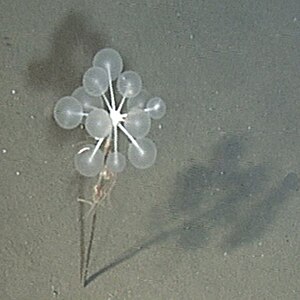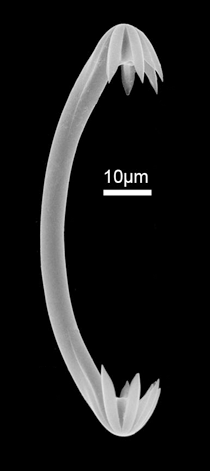Chondrocladia
| Chondrocladia | ||||||||||||
|---|---|---|---|---|---|---|---|---|---|---|---|---|

Chondrocladia lampadiglobus |
||||||||||||
| Systematics | ||||||||||||
|
||||||||||||
| Scientific name | ||||||||||||
| Chondrocladia | ||||||||||||
| Thomson , 1873 |
Chondrocladia is a genus of carnivorous horned silica sponges of the family Cladorhizidae , which belong to the mycaline Poeciloscleriden . Thegenus Neocladia , which waspreviously synonymous with Chondrocladia , was described as an independent genus in 2008, so that only a part of the species remained in the genus Chondrocladia . So far 33 species have been described within the genus, two other species are known but not yet described. Some species are known so far only in single specimens ( Chondrocladia occulta ), therefore their assignment to the genusChondrocladia unsafe. Sponges of the genus Chondrocladia sit on a stem that is anchored in the ground by a rhizoid . Sometimes their egg-shaped body has branches that end in balls. Fossils that can be assigned to this genus have existed since the Pleistocene . However, since they were mainly found in deep-sea habitats , they could have existed since the Mesozoic , because they have characteristic sclerites (also called microcricorrhea or trochirhabden ), which are known from 200 million year old lower Jurassic formations.

Diet
The sponges of the genus Chondrocladia became known to the public for their carnivorous diet. This was first found in a newly discovered species that was found during an expedition of the German research vessel Polarstern as part of the Cedamar project. Carnivorous sponges use hooked sclerites to catch small crustaceans . This has been known since the discovery of Asbestopluma hypogea . This sponge was discovered in 1995 in the Mediterranean in coastal caves near the French city of La Ciotat . The carnivorous diet is now considered common and typical in the Cladorhizidae family . Members of the genus Chondrocladia have the collar flagellum cells typical of sponges , but in a form that allows them to develop inflatable, balloon-like structures that are used to capture the prey.
species
The species of the genus Chondrocladia :
- Chondrocladia albatrossi Tendal, 1973
- Chondrocladia amphactis (Schmidt, 1880)
- Chondrocladia antarctica Hentschel, 1914
- Chondrocladia arctica (Hansen, 1885)
- Chondrocladia arenifera Brøndsted, 1929
- Chondrocladia asigmata Lévi, 1964
- Chondrocladia burtoni Tendal, 1973
- Chondrocladia clavata Ridley & Dendy, 1886
- Chondrocladia concrescens (Schmidt, 1880)
- Chondrocladia crinita Ridley & Dendy, 1886
- Chondrocladia dichotoma Lévi, 1964
- Chondrocladia fatimae Boury-Esnault & Van Beveren, 1982
- Chondrocladia gigantea (Hansen, 1885)
- Chondrocladia gracilis Lévi, 1964
- Chondrocladia guiteli Topsent, 1904
- Chondrocladia koltuni Vacelet, 2006
- Chondrocladia lampadiglobus Vacelet, 2006
- Chondrocladia levii Cristobo, Urgorri & Ríos, 2005
- Chondrocladia lyra Lee et al. , 2012
- Chondrocladia magna Tanita, 1965
- Chondrocladia michaelsarsii Arnesen, 1920
- Chondrocladia multichela Lévi, 1964
- Chondrocladia nani Boury-Esnault & Van Beveren, 1982
- Chondrocladia nicolae Cristobo, Urgorri & Ríos, 2005
- Chondrocladia nucleus (Hansen, 1885)
- Chondrocladia occulta
- Chondrocladia pulvinata Lévi, 1964
- Chondrocladia scolionema Lévi, 1964
- Chondrocladia stipitata Ridley & Dendy, 1886
- Chondrocladia vaceleti Cristobo, Urgorri & Ríos, 2005
- Chondrocladia verticillata Topsent, 1920
- Chondrocladia virgata Thomson, 1873 ( type species )
- Chondrocladia yatsui Topsent, 1930
Individual evidence
- ^ Van Soest (2008)
- ↑ Vacelet (2008)
- ↑ Cristobo et al. (2005), Vacelet & Kelly (2008)
- ^ Sepkoski (2002): p.560
- ↑ Vacelet & Kelly (2008)
- ↑ Brandt et al. (2007), Scales (2007)
- ↑ “Census of the Diversity of Abyssal Marine Life” ( Memento of the original from August 7, 2012 in the Internet Archive ) Info: The archive link was automatically inserted and not yet checked. Please check the original and archive link according to the instructions and then remove this notice.
- ↑ Vacelet & Boury-Esnault (1995)
- ^ Watling (2007), Vacelet (2008)
- ↑ Vacelet (2008), Vacelet & Kelly (2008)
- ↑ Vacelet & Kelly (2008), van Soest (2008)
literature
- Brandt, Angelika et al .: First insights into the biodiversity and biogeography of the Southern Ocean deep sea. In: Nature 447 (7142): 307-311. doi : 10.1038 / nature05827
- Cristobo, Francisco Javier, et al. (2005): Three new species of carnivorous deep-sea sponges from the DIVA-1 expedition in the Angola Basin (South Atlantic). In: Organisms Diversity & Evolution 5 (Supplement 1): 203-213. doi : 10.1016 / j.ode.2004.11.004
- Scales, Helen (2007): Bizarre new deep-sea creatures found off Antarctica . In: National Geographic News , version of May 16, 2007. Retrieved May 17, 2007.
- Sepkoski, J. John Jr. (2002): A compendium of fossil marine animal genera. In: Bulletins of American Paleontology 364. 1-563.
- Vacelet, Jean (2008): A new genus of carnivorous sponges (Porifera: Poecilosclerida, Cladorhizidae) from the deep NE Pacific, and remarks on the genus Neocladia . In: Zootaxa 1752: 57-65. PDF abstract
- Vacelet, Jean & Boury-Esnault, N. (1995): Carnivorous sponges. In: Nature 373 (6512): 333-335. doi : 10.1038 / 373333a0
- Vacelet, Jean & Kelly, Michelle (2008): New species from the deep Pacific suggest that carnivorous sponges date back to the Early Jurassic. In: Nature Precedings , posted September 25, 2008. PDF (683 kB)
- van Soest, Rob (2008): Chondrocladia Thomson, 1873 . In: Van Soest et al. (Ed.): World Porifera database. Retrieved December 18, 2008.
- Watling, Les (2007): Predation on copepods by an Alaskan cladorhizid sponge. In: Journal of the Marine Biological Association of the UK 87 (6): 1721-1726. doi : 10.1017 / S0025315407058560